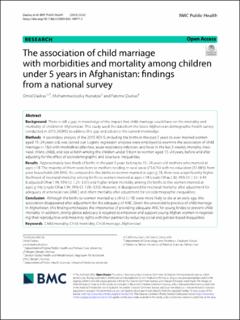| dc.description.abstract | Background
There is still a gap in knowledge of the impact that child marriage could have on the mortality and morbidity of children in Afghanistan. This study used the data from the latest Afghanistan demographic health survey conducted in 2015 (ADHS) to address this gap and advance the current knowledge.
Methods
A secondary analysis of the 2015 ADHS, including the births in the past 5 years to ever-married women aged 15–24 years old, was carried out. Logistic regression analyses were employed to examine the association of child marriage (< 18y) with morbidities (diarrhea, acute respiratory infection, and fever in the last 2 weeks), mortality (neonatal, infant, child), and size at birth among the children under 5 born to women aged 15–24 years, before and after adjusting for the effect of sociodemographic and structural inequalities.
Results
Approximately two-thirds of births in the past 5 years belong to 15–24 years old mothers who married at ages < 18. The majority of them were born to mothers residing in rural areas (75.67%) with no education (51.68%) from poor households (39.39%). As compared to the births to women married at ages ≥ 18, there was a significantly higher likelihood of neonatal mortality among births to women married at ages < 18 (crude OR = 2.30, 95% CI: 1.52–3.49 & adjusted OR = 1.94, 95% CI: 1.25–3.01) and higher infant mortality among the births to the women married at ages ≤ 14y (crude OR = 1.94, 95% CI: 1.06–3.53). However, it disappeared for neonatal mortality after adjustment for adequacy of antenatal care (ANC) and infant mortality after adjustment for sociodemographic inequalities.
Conclusion
Although the births to women married as a child (< 18) were more likely to die at an early age, this association disappeared after adjustment for the adequacy of ANC. Given the unavoidable practice of child marriage in Afghanistan, this finding emphasizes the importance of providing adequate ANC for young brides to prevent child mortality. In addition, strong global advocacy is required to empower and support young Afghan women in negotiating their reproductive and maternity rights with their partners by reducing social and gender-based inequalities. | en_US |

